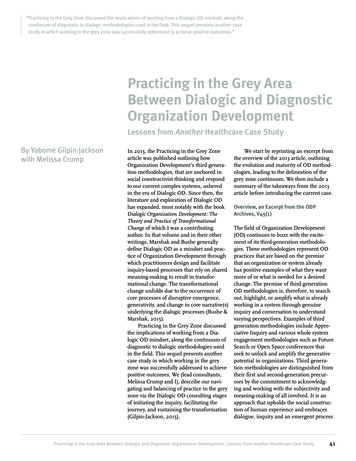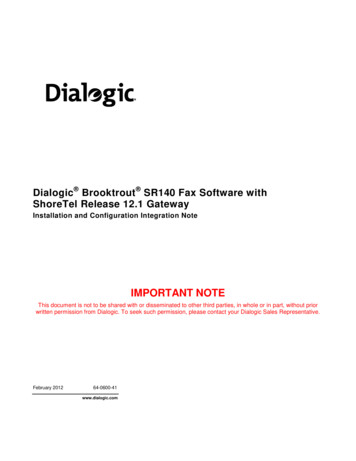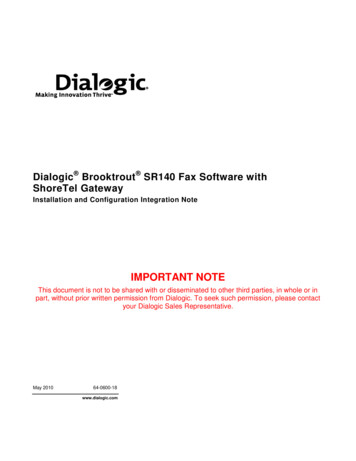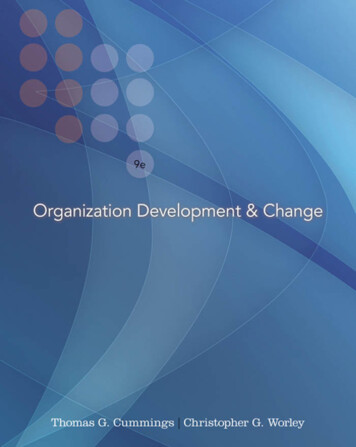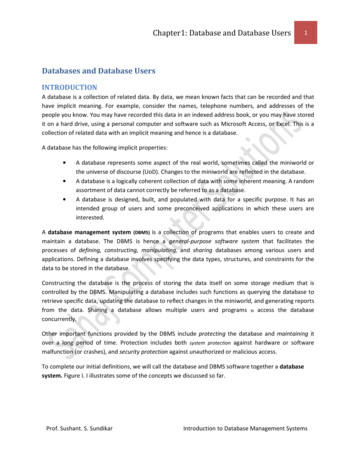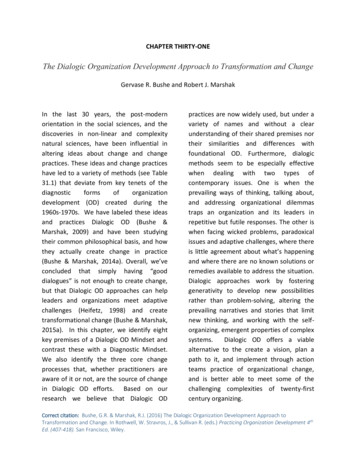
Transcription
CHAPTER THIRTY-ONEThe Dialogic Organization Development Approach to Transformation and ChangeGervase R. Bushe and Robert J. MarshakIn the last 30 years, the post-modernorientation in the social sciences, and thediscoveries in non-linear and complexitynatural sciences, have been influential inaltering ideas about change and changepractices. These ideas and change practiceshave led to a variety of methods (see Table31.1) that deviate from key tenets of thediagnosticformsoforganizationdevelopment (OD) created during the1960s-1970s. We have labeled these ideasand practices Dialogic OD (Bushe &Marshak, 2009) and have been studyingtheir common philosophical basis, and howthey actually create change in practice(Bushe & Marshak, 2014a). Overall, we’veconcluded that simply having “gooddialogues” is not enough to create change,but that Dialogic OD approaches can helpleaders and organizations meet adaptivechallenges (Heifetz, 1998) and createtransformational change (Bushe & Marshak,2015a). In this chapter, we identify eightkey premises of a Dialogic OD Mindset andcontrast these with a Diagnostic Mindset.We also identify the three core changeprocesses that, whether practitioners areaware of it or not, are the source of changein Dialogic OD efforts. Based on ourresearch we believe that Dialogic ODpractices are now widely used, but under avariety of names and without a clearunderstanding of their shared premises northeir similarities and differences withfoundational OD. Furthermore, dialogicmethods seem to be especially effectivewhen dealing with two types ofcontemporary issues. One is when theprevailing ways of thinking, talking about,and addressing organizational dilemmastraps an organization and its leaders inrepetitive but futile responses. The other iswhen facing wicked problems, paradoxicalissues and adaptive challenges, where thereis little agreement about what’s happeningand where there are no known solutions orremedies available to address the situation.Dialogic approaches work by fosteringgenerativity to develop new possibilitiesrather than problem-solving, altering theprevailing narratives and stories that limitnew thinking, and working with the selforganizing, emergent properties of complexsystems.Dialogic OD offers a viablealternative to the create a vision, plan apath to it, and implement through actionteams practice of organizational change,and is better able to meet some of thechallenging complexities of twenty-firstcentury organizing.Correct citation: Bushe, G.R. & Marshak, R.J. (2016) The Dialogic Organization Development Approach toTransformation and Change. In Rothwell, W. Stravros, J., & Sullivan R. (eds.) Practicing Organization Development 4thEd. (407-418). San Francisco, Wiley.
Table 31.1 Examples of Dialogic OD Methods1. Art of Convening (Neal and Neal)21. Preferred Futuring (Lippitt)2. Art of Hosting (artofhosting.org)22. Reflexive Inquiry (Oliver)3. Appreciative Inquiry (Cooperrider)23. REAL model (Wasserman & Gallegos)4. Charrettes (Lennertz)24. Real Time Strategic Change (Jacobs)5. Community Learning (Fulton)25. Re-Description (Storch)6. Complex Responsive Processes of Relating(Shaw)26. Search Conference (Emery & Emery)7. Conference Model (Axelrod)27. Six Conversations (Block)28. SOAR (Stavros)8. Coordinated Management of Meaning(Pearce & Cronen)29. Social Labs (Hassan)9. Cycle of Resolution (Levine)30. Solution Focused Dialogue (Jackson &McKergow)10. Dynamic Facilitation (Rough)11. Engaging Emergence (Holman)12. Future Search (Weisbord)13. Intergroup Dialogue (Nagada, Gurin)14. Moments of Impact (Ertel & Solomon)15. Narrative Mediation (Winslade & Monk)16. Open Space Technology (Owen)31. Sustained Dialogue (Saunders)32. Syntegration (Beer)33. Systemic Sustainability (Amodeo & Cox)34. Talking stick (preindustrial)35. Technology of Participation (Spencer)36. Theory U (Scharmer)37. Visual Explorer (Palus & Horth)17. Organizational Learning Conversations(Bushe)38. Whole Scale Change (Dannemiller)18. Participative Design (M. Emery)39. Work Out (Ashkenas)19. PeerSpirit Circles (Baldwin)40. World Café (Brown & Issacs)20. Polarity Management (Johnson)Correct citation: Bushe, G.R. & Marshak, R.J. (2015) The Dialogic Organization Development Approach toTransformation and Change. In Stravros, J., Rothwell, W. & Sullivan R. (eds.) Practicing Organization Development 4thEd. (407-418). San Francisco, Wiley.
EIGHT KEY PREMISES OF DIALOGICODDialogic OD is still an evolving convergenceof newer premises, principles, and resultingpractices that lead practitioners toapproach situations with a different way ofthinking and acting. We hope to speed upthis convergence by giving it its own nameand identity - Dialogic OD - and inviting ODpractitioners into a conversation about itsunderlying premises and practices, bothnow and going forward.Based on our review of the range ofmethods listed in Table 31.1 and an indepth analysis of six major theories ofDialogic OD practice (Bushe & Marshak,2014b), we have identified eight keypremises that we believe shape the DialogicOD mindset: a set of fundamental beliefsabout organizations and change that differin important ways from the thinking foundin Diagnostic OD.1. Reality and relationships are sociallyconstructed. The Dialogic OD mindsetbelieves that organizations are sociallyconstructed realities. It is how we sociallydefine and describe objective andsubjective “facts” that influence whatpeople think and do. In every conversation,this reality is being created, maintained,and/or changed. Furthermore, there is nosingle objective social reality. Instead, thereare many different “truths” about anyorganization, some dominant and someperipheral.2. Organizations are meaning making systems.The Dialogic OD mindset thinks oforganizations not just as open systemsinteracting with an environment, but asdialogic systems in which people arecontinuously sense-making and meaningmaking, individually and in groups. Whathappens in organizations is influenced moreby how people interact and make meaningthen how presumably objective externalfactors and forces impact the system.3. Language, broadly defined, matters. TheDialogic OD mindset thinks that words (andother forms of communication) do morethan convey information, they createmeaning. Thinking is powerfully influencedby written and verbal communications andthe underlying narratives, stories andmetaphors people use when engaging witheach other.Change is created andsustained by changing what words meanand by changing the words, stories andnarratives that are used in groups andorganizations.4. Creating change requires changingconversations. The social construction ofreality occurs through the conversationspeople have, everyday. Change requireschanging the conversations that normallytake place. This can occur from changingwho is in conversation with whom (e.g.,increasing diversity, including marginalizedvoices), what is being talked about, howthose conversations take place, increasingconversational skills, and by asking what isbeing created from the content and processof current conversations.5. Groups and organizations are inherentlyself-organizing. The Dialogic OD mindsetbelieves that organizations are selforganizing, emergent systems where social2Forthcoming in Practicing Organization Development (4th Edition), Wiley.
reality is being constructed every day. TheDialogic OD mindset finds it more useful tothink of organizations as continuous flows,rather than stable entities, where differentprocesses, structures and ideas vary in howquickly they are changing. OD practitionersmay nudge, accelerate, deflect, punctuate,or disrupt these normal processes, but theydo not unfreeze and re-freeze them.Stakeholders who care about the state ofthe system, who are able to develop richenough information networks, and are notconstrained by any one group’s power, willfrequently find ways to respond tochallenges that are too complex for leadersto successfully address through planningand controlling approaches. Instead, theleader’s job in Dialogic OD approaches is tocreate spaces where useful changes canemerge, and then support and amplifythose changes.6. Increase differentiation in participativeinquiry and engagement before seekingcoherence.InfoundationalOD,organizational system members areinvolved at various times in diagnosingthemselves and making action choices toaddress identified issues. The Dialogic ODmindset reflects a much broaderconception of engagement that is based onmethods of inquiry intended to discovernew and transformational possibilities. Theresulting processes of participative inquiry(rather than diagnosis), engagement, andreflection are designed to: a) maximizediversity, b) encourage stakeholders tovoice their unique perspectives, concernsand aspirations, and c) surface the varietyof perspectives and motivations in thesystem, without privileging anyone, beforeseeking new convergences and coherence.7. Transformational change is more emergentthan planned. Transformational changecannot be planned toward somepredetermined future state.Rather,transformation requires holding anintention while moving into the unknown.Disrupting current patterns in a way thatengages people in uncovering collectiveintentions and shared motivations isrequired. As a result, change processes aremore opportunistic and heterarchichal,where change can and does come fromanywhere in the organization, more thanplanned, hierarchical and top-down.8. Consultants are a part of the process, notapart from the process. OD practitionerscannot stand outside the social constructionof reality, acting as independent facilitatorsof social interaction. Their mere presence ispart of the discursive context thatinfluences the meaning making takingplace. OD practitioners need to be aware oftheir own immersion in the organizationand reflexively consider what meaningsthey are creating and what narratives theiractions are privileging and marginalizing.As shown in Figure 31.1, these premiseslead to different ways of thinking about thebasic building blocks of organizationtransformation and change, even aspractitioners may on the surface seem toengage in similar steps as in Diagnostic OD.For example, one can use AI methodsdiagnostically: collect and analyze storiesduring Discovery, identify preferred3Forthcoming in Practicing Organization Development (4th Edition), Wiley.
outcomesduringDream,proposealternative actions during Design, andchoose and implement changes duringDestiny. Yet when decisions and actionsfollow from a Dialogic OD mindset, thechoices made and actions taken will be verydifferent (Bushe, 2012). As Shaw (2002)notes in discussing foundational OD,“Above all I want to propose that iforganizing is understood essentially as aconversational process, an inescapably selforganizing process of participating in thespontaneous emergence of continuity andchange, then we need a rather differentway of thinking about any kind oforganizational practice that focuses onchange” ( p. 11).Figure 31.1. Contrasting Polar Ideal Types: Diagnostic and Dialogic MindsetsFrom Bushe, G.R., & Marshak, R.J. (2014b). The dialogic mindset in organization development. Research inOrganizational Change and Development, 22, p.86.4Forthcoming in Practicing Organization Development (4th Edition), Wiley.
THE CORE PROCESSES OFTRANSFORMATIONAL CHANGE INDIALOGIC ODSimply having good “dialogues”, creatingspaces where people are willing and able tospeak their minds and listen carefully to oneanother,isnotsufficientfortransformational change to occur. Wepropose that three underlying changeprocesses, singly or in combination, areessential to the successful use of any of theDialogic OD methods listed in Table 31.1(Bushe & Marshak, 2015a). Said anotherway, we believe that failures of any DialogicOD method to stimulate transformationalchange is a result of none of the followingthree transformational processes havinghappened.Transformational Process 1: EmergenceTransformation Process 1 is when adisruptionintheongoingsocialconstruction of reality is stimulated orengaged in a way that leads to a morecomplex re-organization. This disruptionoccurs when the previous order or patternof social relations falls apart, and there islittle chance of going back to the way thingswere. Disruptions can be planned orunplanned, and the group or organizationmay be able to self-organize around themwithout much conscious leadership. From aDialogicODperspective,however,transformation is unlikely to take placewithout disruption of the “established”meaning-making processes (Holman, 2015;Stacey, 2015).A variety of Dialogic OD methods can beused to create containers for productiveconversations to take place that support reorganizing at higher levels of complexitydespite the anxiety that disruptive endingscan create. However, once disrupted, it isimpossible to plan or control what mightthen happen; the options range fromcomplete dissolution to reorganization at ahigher level of complexity (Prigogine &Stengers, 1984). Practitioners operatingfrom a dialogic mindset tend to encourageleaders to confront and push the systemclose to chaos while expanding hanpursuingdiagnostically induced planned change froma current to a desired future state. It is atthe close to chaos boundary that selforganizing changes can emerge (Kauffman,1995; Pascale, Milleman & Gioa, 2001).Dialogic OD practitioners assume that fullyengaging organizational members in suchself-organization will lead to more impactfulchanges, more quickly, than attempts toplan and implement prescribed changes.Transformational Process 2: NarrativeTransformational Process 2 is when there isa change to one or more core narratives.Core narratives are the storylines peopleuse to explain and bring coherence to theirorganizational lives by making sense ofongoing “facts” and events. Changing whatpeople think or their social agreements for example about the role of women inorganizations, or about hierarchicalCorrect citation: Bushe, G.R. & Marshak, R.J. (2015) The Dialogic Organization Development Approach toTransformation and Change. In Stravros, J., Rothwell, W. & Sullivan R. (eds.) Practicing Organization Development 4thEd. (407-418). San Francisco, Wiley.
structures, or even about how changehappens in organizations - requireschanging the common, prevailing storylinesendorsed by those presently and/orhistorically in power (Marshak & Grant,2008). Stories are a way of managingchange, particularly culture change, andtransformationalchangeisoftenconstituted by transformations in thenarratives that participants author (e.g.,Brown & Humphreys 2003; Buchanan &Dawson, 2007). A variety of the methodslisted in Table 31.1 can be used as aconscious intervention into the narrativesand story making processes of anorganization (Storch, 2015; Swart, 2015).Transformational Process 3: GenerativityThe third transformation process happenswhen a generative image is introduced orsurfaces that provides new and compellingalternatives for thinking and acting. Agenerative image is one or more words,pictures, or other symbols that provide newways of thinking about social andorganizational reality. They, in effect, allowpeople to imagine alternative decisions andactions that could not be imagined beforethegenerativeimagesurfaced.“Sustainable development” is one iconicexample of a generative image. Eventhough it cannot be defined (one quality oftruly generative images) it continues to spinoff innovations more than 25 years after itwas first coined. A second property ofgenerative images is that they arecompelling; people want to act on the newopportunities the generative image evokes.A variety of the methods listed in Table 31.1are often supported by using generativeimages as the initiating themes or questionsfor inquiry (Bushe, 2013b) or by evokingnew generative images in the process ofdialogue and inquiry (Storch & Ziethen,2013). Bushe’s research has found thatgenerative images are central to successfulapplications of AI (Bushe, 1998, 2010,2013a; Bushe & Kassam, 2005), and wepropose that they are also central toDialogic OD approaches more broadlydefined (Bushe & Storch, 2015).WHAT DO DIALOGIC ODPRACTITIONERS DO?Dialogic OD practice differs along acontinuum from episodic change practicesto continuous change practices (Bushe &Marshak, 2014a).An episodic changepractice focuses on one or more eventsintended to help a group or organizationtransform from one semi-stable state toanother. A continuous change practice isbased on a stream of ongoing interactionsintended to make small alterations to theongoing patterns of interaction or selforganization that, over time, accumulateinto a transformed state of being.Those sponsoring Dialogic OD usually donot know exactly what changes are needed,wanted or how to achieve them. Thecomplexity of the issues and dynamicsleaders and organizations face in the 21stcentury world of work means thatapplication of “best practices” or preexisting knowledge to identify and then1Forthcoming in Practicing Organization Development (4th Edition), Wiley.
implement change is unlikely to besuccessful. This has been described byHeifetz (1998) as the difference betweentechnical problems and adaptive challenges,and by Snowden & Boone (2000) as thedifference between complicated andcomplex decision situations. Dialogic ODpractitioners believe that dialogic processesare the most effective way to deal withadaptive, complex challenges. During theentry process, the Dialogic OD practitionerwill work with the sponsors to identify, ingeneral, their intentions and the range ofpotentially affected stakeholders who needto be engaged in the Dialogic OD process.They may or may not decide it is importantto create a “planning” or “hosting” groupthat in some way represents thosestakeholders to help architect the changeeffort. This is usually more important whenthe change involves a complex issue, forexample: transportation in the region,where there’s a need to engage a large orvery large group of stakeholders and whenoperating from a more episodic changemindset. It’s critical at this stage for theOD practitioner and the sponsor to agree onthe desired directions of the change effortand for the sponsor to be able and willing tomake the necessary resources, particularlytime, money, and personal commitment,available for the project.Some Dialogic OD methods involveparticipants in becoming explicitly aware ofthe stories, narratives, and patterns ofdiscourse they are embedded in whileothers do not. In either case, all assumethat personal and/or organizational changewill require a change in those narratives.Some focus primarily on changing thediscourse while others focus on bothdiscourse and the changes in decisions andaction that emerge from it. Like DiagnosticOD, Dialogic OD involves both structuredinterventions (like action research) andexperiential interventions (like processconsultation). In the following we brieflysummarize both types of Dialogic ODpractice.Structured Dialogic ODStructured Dialogic OD involves one ormore events. These events are designed sothat relationships and communications areenhanced to enable more creativity andengagement.Practitioners create a“container” (Corrigan, 2015) within whichnew conversations can take place, newrelationships forged, and ideas for changeemerge. Much of the difference in DialogicOD methods concerns ways of orchestrating(rather than facilitating) what happens inthese containers. In all cases, whensuccessful, participants make personal,voluntary commitments to new behaviorsandprojects.Anemergentorimprovisational, as opposed to a plannedimplementation, approach to the actionphase is generally used.Events areintended to generate and support selforganizing groups with ideas for change totake action, without knowing which ofthese will actually be successful.Practitioners work with leaders to watchand learn, cultivate the ideas that lead the2Forthcoming in Practicing Organization Development (4th Edition), Wiley.
organization in the desired direction,amplify their impact, and embed them n, & Bushe, 2015)Unstructured Dialogic ODWe refer to less structured approaches toDialogic ODas “dialogic processconsultation”.In these approaches, apractitioner will bring a dialogic mindset toone-on-one and small group interactions.In some approaches to dialogic processconsultation, the OD practitioner helpsindividuals become aware of and take morecontrol over the prevailing images,metaphors, and narratives that are shapinghow people think and act (Marshak, 2013).They may focus attention to the ways inwhich conversations that differ from theprevailing wisdom are restricted orencouraged, for example the degree towhich a diversity of participants andperspectives are included or excluded in keyorganizational decisions. They may inviteconsideration of processes of generativity;especially how to foster new images thatwill influence the ongoing construction andre-construction of social reality (Storch &Ziethen, 2013).The most provocative approaches todialogic process consultation are based onconcepts of complexity, meaning making,emergence, and self-organization. Thesedialogicprocessactivitiesassumerelationships and organizations arecontinuouslyre-creatingthemselvesthrough the on-going conversations thatoccur at all levels and parts of anorganization, (Shaw, 2002; Stacey, 2015).Any shifts in the nature of theseconversations,forexample,theirparticipants, emphases, or patterns, willencourage incremental shifts that leadgroups to self-organize in new and differentways without the need to bring anything toawareness. There is no use of speciallystructured events to shift from a currentstate to a more desired future state(Goppelt & Ray, 2015; Ray & Goppelt,2013). Instead the OD practitioner entersinto a team or organization that is assumedto be in the continuous process ofbecoming, participates fully in the ongoinglife of the system while seeking to drawattention to, or modify, any on-goingdialogic patterns that may be blocking orlimiting the organization’s ability to evolve,and/or by accentuating differences thatmight encourage new patterns to emerge.SUMMARYDialogic and Diagnostic OD are not twodifferent things – they are different ways ofthinking. We believe they both exist, moreor less, in the mental maps of individual ODpractitioners. Like yin and yang, they cancombine in a myriad of ways to affect an ODpractitioner’s choices and actions. Weadvocate avoiding either/or arguments and,instead, inquiry into the opportunities forchange each mindset provides separatelyand in combination.It is unclear to us, at this time, whetherdialogic transformational change requiresall or most all of the eight premises, and3Forthcoming in Practicing Organization Development (4th Edition), Wiley.
more than one of the three coretransformationalprocessestobesuccessful. To us and other Dialogic ODpractitioners they do seem related, eitherexplicitly or implicitly. It is difficult toimagine, for example, a change in a corenarrative that did not also involve adisruption to the prevailing socialconstruction of reality. But changes in corenarratives do occur over time, which do notnecessarily involve an abrupt disruption. Ina world of constant change, however,“disruption” is mainly a matter of temporalperspective. Our current proposition is thattransformational change from Dialogic ODresults from some combination of the threechange processes as supported by the eightkey premises. Hopefully, Dialogic OD, andthe narrative advanced in this chapter,serves as a generative image evoking newinsights into the potential for OD practicesto transform organizations and realize moreeffective organizing.REFERENCESBrown, A. D., & Humphreys, M. (2003). Epicand tragic tales: Making sense of change.Journal of Applied Behavioral Science,39(2), 121-144.Buchanan, D., & Dawson, P. (2007).Discourse and audience: organizationalchange as multi‐story process. Journal ofManagement Studies, 44(5), 669-686.Bushe, G.R. (1998) Appreciative inquiry inteams. Organization DevelopmentJournal, 16(3), 41-50.Bushe, G.R. (2010). A comparative casestudy of appreciative inquiries in oneorganization: Implications for practice.Review of Research and SocialIntervention, 29, 7-24.Bushe, G.R. (2012). Appreciative inquiry:Theory and critique. In D. Boje, B.Burnes, & J. Hassard (eds.) The Routledgecompanion to organizational change (pp.87-103). Oxford, UK: Routledge.Bushe, G.R. (2013a). Generative process,generative outcome: The transformational potential of appreciative inquiry.In D.L. Cooperrider, D.P. Zandee, L.Godwin, M. Avital & B. Boland (eds.)Organizational generativity (Advances inappreciative inquiry, vol.4, 89-122).Bingley, UK: Emerald Press.Bushe, G.R. (2013b). Dialogic OD: A theoryof practice. OD Practitioner, 45(1), 1016.Bushe, G.R., & Kassam, A. (2005). When isappreciative inquiry transformational? Ameta-case analysis. Journal of AppliedBehavioral Science, 41(2), 161-181.Bushe, G.R., & Marshak, R.J. (2009).Revisioning organization development:Diagnostic and dialogic premises andpatterns of practice. Journal of AppliedBehavioral Science, 45(3), 348-368.Bushe, G.R., & Marshak, R.J. (2014a)Dialogic organization development. InJones, B.B. & M. Brazzel, (eds.) The NTLhandbook of organization developmentand change, 2nd Ed. (pp.193-211). SanFrancisco, CA: Wiley.4Forthcoming in Practicing Organization Development (4th Edition), Wiley.
Bushe, G.R., & Marshak, R.J. (2014b). Thedialogic mindset in organizationdevelopment. Research inOrganizational Change andDevelopment, 22, 55-97.Holman, P. (2015) Complexity, selforganization and emergence In G.R.Bushe, & R.J. Marshak, (eds.) Dialogicorganization development (pp.123-149).Oakland, CA: Berrett-Koehler.Bushe, G.R., & Marshak, R.J. (eds.) (2015a)Dialogic organization development: Thetheory and practice of transformationalchange. Oakland, CA: Berrett-Koehler.Kauffman, S. (1995). At home in theuniverse: The Search for the laws of selforganization and complexity. New YorkCity, NY: Oxford University Press.Bushe, G.R., & Marshak, R.J. (2015b)Introduction to the dialogic organizationdevelopment mindset. In G.R. Bushe &R.J. Marshak, (eds.) Dialogic organizationdevelopment (pp.11-32) Oakland, CA:Berrett-Koehler.Marshak, R.J. (2013) Leveraging languagefor change. OD Practitioner, 45(2), 4955.Bushe, G.R., & Storch, J. (2015) Generativeimage: Sourcing novelty. In G.R. Bushe,& R.J. Marshak, (eds.) Dialogicorganization development (pp.101-122)Oakland, CA: Berrett-Koehler.Corrigan, C. (2015) Hosting and holdingcontainers. In G.R. Bushe, & R.J.Marshak, (eds.) Dialogic organizationdevelopment (pp.291-304). Oakland, CA:Berrett-Koehler.Goppelt, J., & Ray, K.W. (2015) Dialogicprocess consultation: Working live. InG.R. Bushe, & R.J. Marshak, (eds.)Dialogic organization development(pp.371-399). Oakland, CA: BerrettKoehler.Heifetz, R. (1998). Leadership without easyanswers. Cambridge, MA: Harvard.Marshak, R. J., & Grant, D. (2008).Organizational discourse and neworganization development practices,British Journal of Management, 19: S7S19.Pascale, R., Milleman, M., & Gioja, L. (2001).Surfing the edge of chaos. NY: CrownBusiness.Prigogine, I., & Stengers, I. (1984). Order outof chaos. Boulder, CO: Shambhala.Ray, K. W. & Goppelt, J. (2013). Fromspecial to ordinary: Dialogic OD in day-today complexity. OD Practitioner, (45)1,41-46.Roehrig, M., Schwendenwein, J. & Bushe,G.R. (2015) Amplifying change: A 3-phaseapproach to model, nurture and embedideas for change. In G.R. Bushe, & R.J.Marshak, (eds.) Dialogic organizationdevelopment (pp.325-348). Oakland, CA:Berrett-Koehler.5Forthcoming in Practicing Organization Development (4th Edition), Wiley.
Shaw, P. (2002). Changing conversations inorganizations: A complexity approach tochange. London: Routledge.Snowden, D.J., & Boone, M.E. (2007). Aleader’s framework for decision-making.Harvard Business Review, 85(11), 69-76.Stacey, R. (ed.) (2005). Experiencingemergence in organizations. London, UK:Routledge.For more depth on Dialogic OD visitStacey, R. (2015) Understandingorganizations as complex responsiveprocesses of relating In G.R. Bushe, & R.J.Marshak, (eds.) Dialogic organizationdevelopment (pp.151-175). Oakland, CA:Berrett-Koehler.www.dialogicod.netStorch, J. (2015) Enabling change: The skillsof dialogic OD. In G.R. Bushe, & R.J.Marshak, (eds.) Dialogic organizationdevelopment (pp.197-218). Oakland, CA:Berrett-Koehler.Storch, J., & Ziethen, M. (2013). Redescription: A source of generativity indialogic organization development, ODPractitioner, 45(1), 25-29.Swart, C. (2015) Coaching from a dialogicOD paradigm. In G.R. Bushe, & R.J.Marshak, (eds.) Dialogic organizationdevelopment (pp.349-370). Oakland, CA:Berrett-Koehler.6Forthcoming in Practicing Organization Development (4th Edition), Wiley.
Forthcoming in Practicing Organization Development (4th Edition), Wiley. outcomes during Dream, propose alternative actions during Design, and choose and implement changes during Destiny. Yet when decisions and actions follow from a Dialogic OD min
